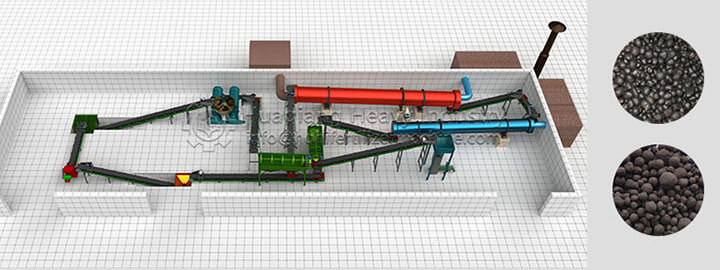An adult pig can excrete 3-5 kg of feces per day, and 10,000 pigs can excrete 30-50 tons per day. Generally, 10,000 pig farms are suitable for organic fertilizer production line equipment with an annual output of 5,000-10,000 tons. Pig manure must undergo high-temperature composting and fermentation for harmless treatment.
The pig manure in the septic tank can be pumped into the dehydrator with a mud pump with a defecation processor. After treatment, the water content of the pig manure is about 40%; it can also be used as fillings for rice straw, rice bran and other crops (including N\P\K), and then sprinkle apply biological hardener. 1KG of fungicide and 20KG of water are mixed with raw materials, and 1 ton of raw materials can be fermented. Turn it once every 1-2 days, and the material will be fully cooked in 7-10 days.
.jpg)
The complete set of pig manure organic fertilizer production equipment includes turning machine, silo, pulverizer, granulator, screening machine, dryer, cooler, mixer, automatic packaging machine, etc. There are many types of these equipment. Different models and configurations are different prices. For example, organic fertilizer granulators include double roller granulator, rotary drum granulator, disc granulator machine, new organic fertilizer granulators, new two-in-one organic fertilizer granulators, flat die granulators, ring die granulator, various granulators have their own production characteristics, and the fertilizer granulator machine price vary. The pig manure organic fertilizer production line has compact layout, advanced technology, stable operation and convenient maintenance;
Zhengzhou Huazhiqiang organic fertilizer equipment manufacturer is based on the principle of honest management, aggressive and pioneering, including organic fertilizer production line, npk production line, etc., perfect after-sales service and supporting facilities, is a company mainly engaged in organic fertilizer granulator, organic fertilizer Turning machine, organic fertilizer pulverizer, organic fertilizer fermentation machine and other organic fertilizer equipment manufacturers for a complete set of organic fertilizer production lines, and the technology development system has won unanimous praise from users.

.jpg)

.jpg)



.jpg)
